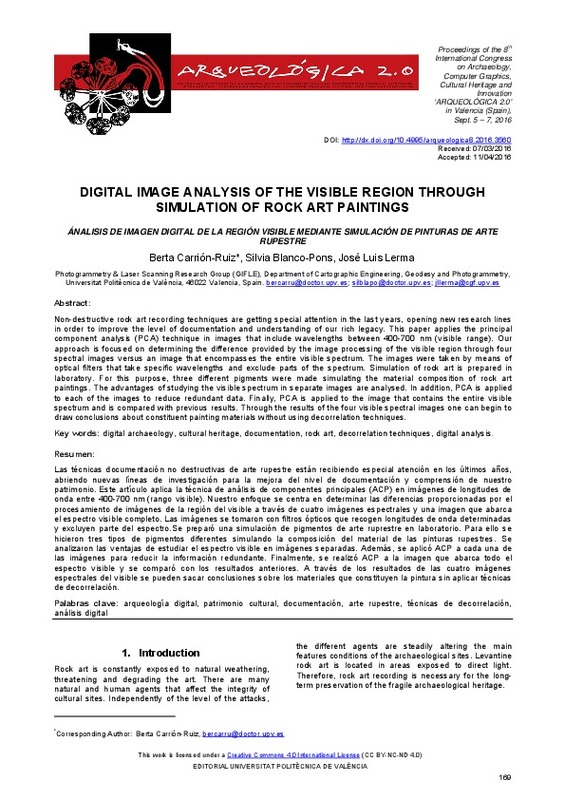JavaScript is disabled for your browser. Some features of this site may not work without it.
Buscar en RiuNet
Listar
Mi cuenta
Estadísticas
Ayuda RiuNet
Admin. UPV
DIGITAL IMAGE ANALYSIS OF THE VISIBLE REGION THROUGH SIMULATION OF ROCK ART PAINTINGS
Mostrar el registro sencillo del ítem
Ficheros en el ítem
| dc.contributor.author | Carrión-Ruiz, Berta
|
es_ES |
| dc.contributor.author | Blanco-Pons, Silvia
|
es_ES |
| dc.contributor.author | Lerma García, José Luis
|
es_ES |
| dc.date.accessioned | 2018-02-05T10:21:14Z | |
| dc.date.available | 2018-02-05T10:21:14Z | |
| dc.date.issued | 2016-10-27 | |
| dc.identifier.isbn | 9788490484555 | |
| dc.identifier.uri | http://hdl.handle.net/10251/96642 | |
| dc.description.abstract | [EN] Non-destructive rock art recording techniques are getting special attention in the last years, opening new research lines in order to improve the level of documentation and understanding of our rich legacy. This paper applies the principal component analysis (PCA) technique in images that include wavelengths between 400-700 nm (visible range). Our approach is focused on determining the difference provided by the image processing of the visible region through four spectral images versus an image that encompasses the entire visible spectrum. The images were taken by means of optical filters that take specific wavelengths and exclude parts of the spectrum. Simulation of rock art is prepared in laboratory. For this purpose, three different pigments were made simulating the material composition of rock art paintings. The advantages of studying the visible spectrum in separate images are analysed. In addition, PCA is applied to each of the images to reduce redundant data. Finally, PCA is applied to the image that contains the entire visible spectrum and is compared with previous results. Through the results of the four visible spectral images one can begin to draw conclusions about constituent painting materials without using decorrelation techniques. | es_ES |
| dc.description.abstract | [ES] Las técnicas documentación no destructivas de arte rupestre están recibiendo especial atención en los últimos años, abriendo nuevas líneas de investigación para la mejora del nivel de documentación y comprensión de nuestro patrimonio. Este artículo aplica la técnica de análisis de componentes principales (ACP) en imágenes de longitudes de onda entre 400-700 nm (rango visible). Nuestro enfoque se centra en determinar las diferencias proporcionadas por el procesamiento de imágenes de la región del visible a través de cuatro imágenes espectrales y una imagen que abarca el espectro visible completo. Las imágenes se tomaron con filtros ópticos que recogen longitudes de onda determinadas y excluyen parte del espectro.Se preparó una simulación de pigmentos de arte ruprestre en laboratorio. Para ello se hicieron tres tipos de pigmentos diferentes simulando la composición del material de las pinturas rupestres. Se analizaron las ventajas de estudiar el espectro visible en imágenes separadas. Además, se aplicó ACP a cada una de las imágenes para reducir la información redundante. Finalmente, se realizó ACP a la imagen que abarca todo el espectro visible y se comparó con los resultados anteriores. A través de los resultados de las cuatro imágenes espectrales del visible se pueden sacar conclusiones sobre los materiales que constituyen la pintura sin aplicar técnicas de decorrelación. | es_ES |
| dc.format.extent | 7 | es_ES |
| dc.language | Inglés | es_ES |
| dc.publisher | Editorial Universitat Politècnica de València | es_ES |
| dc.relation.ispartof | 8th International congress on archaeology, computer graphics, cultural heritage and innovation | es_ES |
| dc.rights | Reconocimiento - No comercial - Sin obra derivada (by-nc-nd) | es_ES |
| dc.subject | Digital archaeology | es_ES |
| dc.subject | Cultural heritage | es_ES |
| dc.subject | Documentation | es_ES |
| dc.subject | Rock art | es_ES |
| dc.subject | Decorrelation techniques | es_ES |
| dc.subject | Digital analysis | es_ES |
| dc.title | DIGITAL IMAGE ANALYSIS OF THE VISIBLE REGION THROUGH SIMULATION OF ROCK ART PAINTINGS | es_ES |
| dc.title.alternative | ÁNALISIS DE IMAGEN DIGITAL DE LA REGIÓN VISIBLE MEDIANTE SIMULACIÓN DE PINTURAS DE ARTE RUPESTRE | es_ES |
| dc.type | Capítulo de libro | es_ES |
| dc.type | Comunicación en congreso | es_ES |
| dc.identifier.doi | 10.4995/arqueologica8.2016.3560 | |
| dc.rights.accessRights | Abierto | es_ES |
| dc.contributor.affiliation | Universitat Politècnica de València. Departamento de Ingeniería Cartográfica Geodesia y Fotogrametría - Departament d'Enginyeria Cartogràfica, Geodèsia i Fotogrametria | es_ES |
| dc.contributor.affiliation | Universitat Politècnica de València. Escuela Técnica Superior de Ingeniería Geodésica, Cartográfica y Topográfica - Escola Tècnica Superior d'Enginyeria Geodèsica, Cartogràfica i Topogràfica | es_ES |
| dc.description.bibliographicCitation | Carrión-Ruiz, B.; Blanco-Pons, S.; Lerma García, JL. (2016). DIGITAL IMAGE ANALYSIS OF THE VISIBLE REGION THROUGH SIMULATION OF ROCK ART PAINTINGS. En 8th International congress on archaeology, computer graphics, cultural heritage and innovation. Editorial Universitat Politècnica de València. 169-175. https://doi.org/10.4995/arqueologica8.2016.3560 | es_ES |
| dc.description.accrualMethod | OCS | es_ES |
| dc.relation.conferencename | ARQUEOLÓGICA 2.0 - 8th International Congress on Archaeology, Computer Graphics, Cultural Heritage and Innovation | es_ES |
| dc.relation.conferencedate | September 05-07,2016 | es_ES |
| dc.relation.conferenceplace | Valencia, Spain | es_ES |
| dc.relation.publisherversion | http://ocs.editorial.upv.es/index.php/arqueologica20/arqueologica8/paper/view/3560 | es_ES |
| dc.description.upvformatpinicio | 169 | es_ES |
| dc.description.upvformatpfin | 175 | es_ES |
| dc.type.version | info:eu-repo/semantics/publishedVersion | es_ES |
| dc.relation.pasarela | OCS\3560 | es_ES |








